The war in Ukraine has forced people of the “West”—a term that has come to mean most of Europe, the United States, Canada, Japan, South Korea, Taiwan, Australia, and New Zealand—to confront a social system that we have pretended went extinct hundreds of years ago: feudalism. While feudalism has mostly disappeared from the above-named nations, it is thriving in Putin’s Russia, as well as many other places around the world.
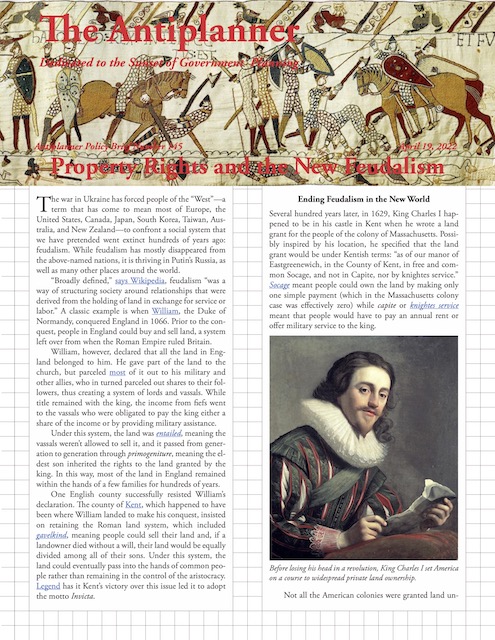 Click image to download a four-page PDF of this policy brief.
Click image to download a four-page PDF of this policy brief.
“Broadly defined,” says Wikipedia, feudalism “was a way of structuring society around relationships that were derived from the holding of land in exchange for service or labor.” A classic example is when William, the Duke of Normandy, conquered England in 1066. Prior to the conquest, people in England could buy and sell land, a system left over from when the Roman Empire ruled Britain.
The Bayeux Tapestry shows how William conquered England and imposed feudalism. Photo by Silvia Calderon.
William, however, declared that all the land in England belonged to him. He gave part of the land to the church, but parceled most of it out to his military and other allies, who in turned parceled out shares to their followers, thus creating a system of lords and vassals. While title to the land remained with the king, the income from fiefs went to the vassals who were obligated to pay the king either a share of the income or by providing military assistance.
Under this system, the land was entailed, meaning the vassals weren’t allowed to sell it, and it passed from generation to generation through primogeniture, meaning the eldest son inherited the rights to the land granted by the king. In this way, most of the land in England remained within the hands of a few families for hundreds of years.
One English county successfully resisted William’s declaration. The county of Kent, which happened to have been where William landed to make his conquest, insisted on retaining the Roman land system, which included gavelkind, meaning people could sell their land and, if a landowner died without a will, their land would be equally divided among all of their sons. Under this system, the land could eventually pass into the hands of common people rather than remaining in the control of the aristocracy. Legend has it Kent’s victory over this issue led it to adopt the motto Invicta.
Ending Feudalism in the New World
Several hundred years later, in 1629, King Charles I happened to be in his castle in Kent when he wrote a land grant for the people of the colony of Massachusetts. Possibly inspired by his location, he specified that the land grant would be under Kentish terms: “as of our manor of Eastgreenewich, in the County of Kent, in free and common Socage, and not in Capite, nor by knightes service.” Socage meant people could own the land by making only one simple payment (which in the Massachusetts colony case was effectively zero) while capite or knightes service meant that people would have to pay an annual rent or offer military service to the king.
 Before losing his head in a revolution, King Charles I set America on a course to widespread private land ownership.
Before losing his head in a revolution, King Charles I set America on a course to widespread private land ownership.
Not all the American colonies were granted land under such liberal terms. The Pennsylvania colony grant to William Penn was made with the expectation that it would be divided up among settlers. But some large land grants, such as grants in Virginia, were entailed under rules of primogeniture. In 1776, Thomas Jefferson persuaded the Virginia legislature to abolish entail, and every other state eventually followed, thus allowing the break-up of large estates.
In the nineteenth century, waves of immigrants came from Europe to the United States, attracted by the opportunity to own their own land, either a farm or a home in a city, an opportunity which was denied most people in Europe. Inspired by America’s example, France abolished entail during the Revolution, and most other European countries eventually followed. However, England didn’t abolish it until 1925, so most of the land in England is still owned by the crown, the aristocracy, large corporations, and a few other landowners, while common homeowners own as little as 5 percent.
Even today, when someone buys a house in England, at some point during the sale process the realtor will solemnly inform the buyer that all the land in England is owned by the Queen and homeowners merely rent it. But that is more of a legal fiction than a reality; if the Queen ever tried to exercise her supposed rights to people’s homes and land, the monarchy would not long survive.
What distinguishes feudalism from western property regimes is the contrasting obligations to the sovereign or the government. Under feudalism, vassals pay the sovereign a share of all they earn from the land. Under modern systems, people may pay taxes but the taxes are democratically determined and are not necessarily proportional to the amount of income they earn from the land. Under feudalism, the sovereign can reclaim the land at any time without compensation. Under modern systems, the government can take land by eminent domain but only with compensation.
Feudalism was successful in the pre-industrial era because the military obligations of vassals to their lords allowed for the rapid gathering of armies for defense or for invading other countries. The development of new technologies meant that wealth production played a bigger role in military success than the mere creation of an army. Modern property rights systems allowed for far greater wealth production and allowed the West to dominate the world.
Despite this, most countries of the world still operate under land systems that are little different from feudal. In pretty much all of Africa, all of South American except Chile, and all of Asia except Japan, South Korea, and Taiwan, most land is still owned by the government or a small aristocracy. Typically, the land is divided up among tribes or villages which manage the land on a communal basis. But the ultimate title for the land is owned by the government, which can take the land from the villages or tribes at any time or override village or tribal decisions about how the land should be managed.
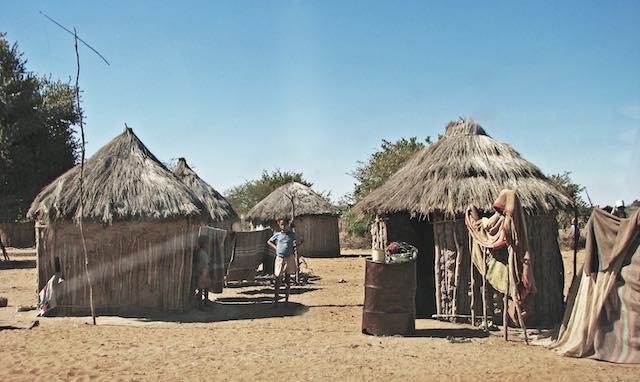 Residents of communally lands such as this village in Namibia have a difficult time building wealth. Photo by Jesse Kipp.
Residents of communally lands such as this village in Namibia have a difficult time building wealth. Photo by Jesse Kipp.
Even in many western countries, significant portions of land remain feudal in nature. Less than 11 percent of Canada is privately owned. Nearly 90 percent of Alaska, more than 80 percent of Nevada, and most of Arizona, Idaho, Oregon, Utah, and Wyoming are owned by the federal or state governments. Most Native American reservations in both Canada and the United States are supposedly collectively owned by the natives but often managed for them by government agencies. Individual ownership of land on such reservations is generally not possible.
As Peruvian economist Hernando de Soto carefully demonstrates in his book, The Mystery of Capital, individual owners with secure title to land can use their property to build wealth in many ways that collective owners of communal lands cannot. Among other things, land that can be bought and sold provides price signals about relative values, makes owners accountable for what they do with the land, can be used as an asset against which money can be borrowed, and helps different owners to network and coordinate with one another. De Soto argues that no one has developed a better system for building wealth, and in a competitive world, wealth accumulation is essential for the survival of nations and cultures.
Industrial Feudalism
In the industrial era, communists in Russia, China, and elsewhere took feudalism the next logical step. Instead of just owning the land, the communists declared that the government owned all of the means of production, including factories, power plants, refineries, natural resources, retail outlets, and housing. As in the case of tribal lands in Africa and Native American reservations in the United States, these lands were supposedly managed for the benefit of all their residents, but in practice a few managers gave themselves special privileges and access to resources not available to most people.
Collective ownership of the means of production failed to give workers and entrepreneurs the incentives to build wealth as fast as in the West, and the Soviet Union collapsed in 1991. Former soviet countries attempted various methods of privatization, often by giving residents vouchers that they could use to buy shares of privatized companies. This process was less successful in some countries than others; in Russia, in particular, the privatization process proved to be very corrupt, with a few people becoming billionaires and many people becoming poorer.
Now Russia is ruled by Putin, and most of the means of production are in the hands of billionaire oligarchs. While the oligarchs are theoretically independent, those who challenge Putin seem to die mysterious deaths. Putin, meanwhile, considers Belarus, Ukraine, and at least some other former soviet countries to be part of his domain and placed his vassals in charge of both, which proved to be unsuccessful in Ukraine.
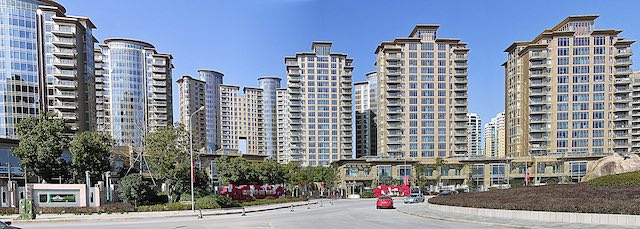 China claims a high homeownership rate, but all of the homes are on land owned by the government, usually under 70-year leases. Photo by Donalddytong.
China claims a high homeownership rate, but all of the homes are on land owned by the government, usually under 70-year leases. Photo by Donalddytong.
China has remained firmly in the grip of a communist government which owns all the land in the country. To overcome the failures of collective ownership, Deng Xiaoping allowed for private ownership of homes and factories on government-owned land and allowed entrepreneurs to keep the wealth they produced. In doing so, China created its own billionaire oligarchs, though it may have done better at creating a middle class than Russia. Still, much of China’s economy remains in the hands of state-owned companies and the country’s growth has been fueled partly if not mostly by unsustainable debt.
The New Feudalism
If much of Africa and South America still operates under agricultural feudalism and much of Asia is under industrial feudalism, a new form of feudalism has developed in the West. Pioneered in Britain, this might be called developmental feudalism but has more commonly been called the new feudalism.
In 1945, a socialist-oriented Labour Party took over the British parliament. In 1947, it passed the Town & Country Planning Act, which continued to allow people to own land but transferred the development rights to that land to the government. This gave planners enormous control over the country and ended up confining 84 percent of the population to just 6 percent of the land.
Britain’s example was followed in many other countries, including much of Europe, Australia, and New Zealand. In Canada, only British Columbia and, to a lesser degree, Ontario passed similar laws. Japan passed a law allowing rural landowners to develop their land but imposing a 150 percent capital gains tax on such developments, effectively calling such developments to a halt, leading to the property bubble of the 1980s that shattered the country’s economy.
In the United States, Hawaii was the first to pass a town-and-country-type land-use law in 1961. This law divided all land in the state into urban, agriculture, and conservation. A “rural” designation was added later, but the point is that the vast majority of land in the state was not urban, thus confining most people to a small share of the land. As of 2010, 82 percent of the population lived on just 8 percent of the land.
Ironically, Hawaii at the time was ruled by an oligarchy consisting of a few families and corporations that owned most of the islands. As documented in the 1984 book, Land and Power in Hawaii, Democrats promised land reform to get control of the legislature. Instead of making more land available to the common people, the Democratic politicians passed the land-use law, effectively making themselves part of the oligarchy.
In 1972, this law and similar laws in Massachusetts, Vermont, and a few other states led staffers at the newly formed Council on Environmental Quality to write approvingly about “the quiet revolution in land use control.” Vermont attorney John McClaughry had a more skeptical name for it: the new feudalism. New feudalists, he says, believe “that development rights must now be recognized as created and allocated to the land by society, and are not attributes of free property ownership.” This requires “extending the police power to its utter limits,” which “rapidly shades into the idea that land is not owned by a freehold owner, but held at the sufferance of society, that is to say, the government.”
The greatest expression of this to date may be in Oregon, which passed a land-use law in 1973 that created a state commission that writes rules that must be followed by every municipality. Following these rules, only 1.3 percent of the state is zoned for urban uses. In most of the land outside of urban areas, a landowner may get a permit to build a house only if they own at least 80 acres, they actually farm it, and they actually earned (depending on soil productivity) $40,000 to $80,000 a year farming it in two of the last three years.
In its urban areas, Oregon was one of the first places to use minimum-density zoning. Traditional zoning sets maximum densities of, say, no more than 4 or 8 homes per acre. Minimum-density zoning also sets a minimum density, which in Oregon is typically 80 percent of the maximum density. This means that in an area zoned for, say, 20 units per acre builders cannot construct fewer than 16 units per acre. Rezoning of single-family neighborhoods to higher densities can make it illegal for someone to build a single-family home on a vacant lot: they must build a multi-family dwelling that is at least 80 percent of the maximum density. At the most extreme, in some zones if someone’s house burns down, they can only replace it with an apartment building.
California’s land-use controls may be the strictest in the nation. As of the 2010 census, they effectively confined 95 percent of the state’s people to just over 5 percent of the state’s land. Unlike in Oregon and Hawaii, it is almost impossible for California communities to expand the amount of land available for housing.
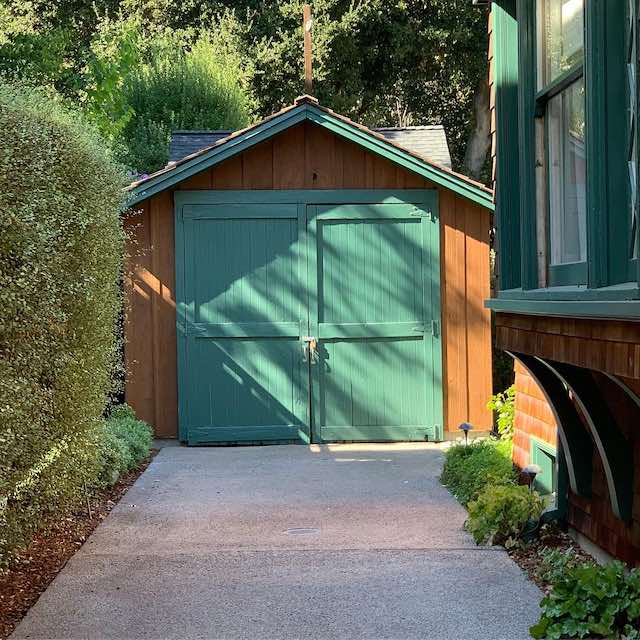 Legend has it that Silicon Valley was started in this Palo Alto garage, which was owned by Hewlett-Packard co-founder David Packard. The reality is that many if not most start-up firms get at least some of their capital from a loan against the collateral of the founder’s home. By driving down homeownership rates, California’s new feudalism is also driving down start-up rates. Photo by Arild Finne Nybø, arnybo.
Legend has it that Silicon Valley was started in this Palo Alto garage, which was owned by Hewlett-Packard co-founder David Packard. The reality is that many if not most start-up firms get at least some of their capital from a loan against the collateral of the founder’s home. By driving down homeownership rates, California’s new feudalism is also driving down start-up rates. Photo by Arild Finne Nybø, arnybo.
One of the effects of the supposedly rational planning process that makes up the quiet revolution is an increase in housing prices. Artificially limiting the land available for housing increases land prices. This pushes up housing prices, which increases the cost of labor required to build new homes. Multi-story high-density housing also costs more per square foot due to the cost of elevators and additional cement and steel needed for construction.
The result is that housing has become too expensive to buy for many people who would otherwise prefer to own a home. Homeownership rates in California, and Oregon have declined since they implemented stricter land-use controls in the 1970s and 1980s. This in turn has increased inequality, which was at its lowest in the late 1960s before the quiet revolution had begun anywhere except Hawaii. Today, inequality in the United States is worse than in China or Russia, and research by economist Matthew Rognlie has concluded that recent increases in inequality are entirely due to the rise in housing prices.
The Great Regression
Today, urbanist Joel Kotkin fears that “we may be entering ‘the great regression,’ a period where the world becomes more hierarchical and feudal, less prosperous, and much less free.” Kotkin’s latest book, The Coming of Neo-Feudalism, warns that the economic mobility that once characterized America and many other western countries is being replaced by a closed class system.
At the top of the hierarchy are two classes, which he calls the clerisy and the oligarchs. The clerisy consists of academics and other intellectuals who dominate opinions on such subjects as the environment and globalism. The property-owning middle-class was once a source of economic mobility but now is “being squeezed beneath the oligarchy.” The largest class of all, the working class, “are becoming more like medieval serfs, with diminishing chances of owning significant assets or improving their lot except with government transfers.” The artificial land scarcities caused by the quiet revolution play an important role in this regression, leaving the middle-class dirt poor (meaning someone who can own a home but has no surplus income for other luxuries) and turning the working class into perpetual renters.
To reverse the great regression, it is time for real land reform. Communal lands in Africa, South America, and other parts of the world should be privatized. Development rights to land in western countries should be returned to their owners. China should privatize its land and state-owned companies. Russia may be hopeless for the foreseeable future, but if enough other countries are able to use land reform to build wealth, Russia will eventually be forced to follow.
Randal O’Toole is a land-use and transportation policy analyst and author of American Nightmare: How Government Undermines the Dream of Homeownership. Masthead photo of a section of the Bayeux Tapestry showing how William conquered England and imposed feudalism is by Silvia Calderon.

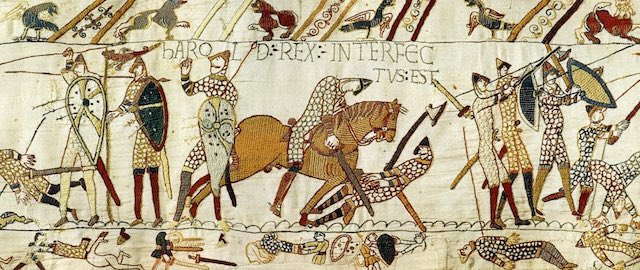







It’s difficult to adapt society to a new mindset.
But we disposed of feudalism NOT with govt reform but severed heads. Africa has never had feudalism in classic sense…. they did have colonialism for 2-3 centuries.
Africa by contrast has had many civil wars, did nothing to reform its governments.
Someone liked your comment
G N liked your comment on Centurion’s Roaring Whips Of Exploding Shells Are Still Engaging Rockets Over Iraq’s Green Zone.
Posted 11/20/2020, 1:49
Low-IQ groups cannot sustain democracy or beneficial form of government. Sub-Saharan Africa; average IQ’s in the 70’s. Had we been allowed to discuss IQ and cognitive research colleges largely banned; the Iraq War would never have occurred…Because no one would have been under the illusion something resembling a “Jeffersonian Republic” would emerge from a nation with an average IQ in the 80’s. Geopolitical stability and political freedom Cannot survive average IQ’s below 90. They will never be democracy; not without a Western referee. Just pack your tanks and rifles and Go Home. Back in 2006, Iraq insisted setting up an Islamic constitution (against US advice) political freedom in Iraq provided it’s ” Morally acceptable ” Average IQ’s in Iraq: 87. Many indigenous socities; IQ’s are in the 80’s thats why tribalism is their form of governing. Meanwhile High IQ Jews & Chinese fled the Holocaust and Cultural Revolution, with NOTHING; in just 2-3 generations matched or exceeded US median Incomes. 400 years exposure to modernity still fail to get ahead. IQ Matters far more than skin color or what you call God(s).
Hillary and Obama destabilized and overthrew Libya. While I was no supporter of Gaddafi; he kept the country stable. The very idea a “Jeffersonian Republic” would emerge from his ousting is laughable…. I do recall many media pundits extol how sophisticated Libyans and Syrians were and that intervention would not degenerate the way Iraq did. F**K EM!
”
most of the means of production are in the hands of billionaire oligarchs.
” ~anti planner
That probably isn’t accurate enough to be true. A lot of Russian companies these days – Gazprom, Rosneft, etc – are majority owned by the government, not the oligarchs.
Furthermore, when we invoke oligarchs in Russia, we have to remember there are 2 groups. The older, smaller group of oligarchs that gained their wealth pre-Putin and the more numerous oligarchs that got their wealth arguably via Putin.
A better background explaining this is here by Dr. Markus. Note he break oligarchs into 3 groups.
https://theconversation.com/meet-russias-oligarchs-a-group-of-men-who-wont-be-toppling-putin-anytime-soon-178474
In today’s WSJ …
YIMBY Movement Goes Mainstream in Response to High Housing Costs
‘Yes in my backyard’ activists in states such as California try to persuade Democrats that more construction is the best solution for homelessness and lack of affordable housing
https://www.wsj.com/articles/yimby-movement-goes-mainstream-in-response-to-high-housing-costs-11650373200?st=q0qrytbnqumb6iy&reflink=desktopwebshare_permalink
There’s enough “Rock” out in the desert to build homes for a million people. Flintstones homes, but…they’re
-bug proof
-fire proof
-mold proof
-indestructable
With todays modern CNC machines you can cut, polish and build homes from cinderblock and stone for cheap.